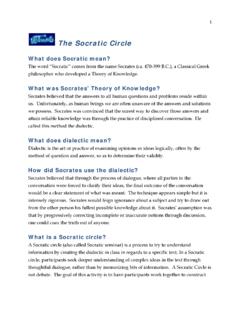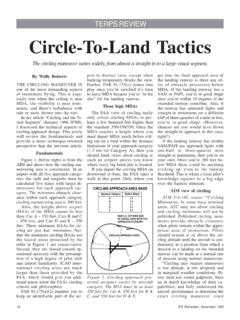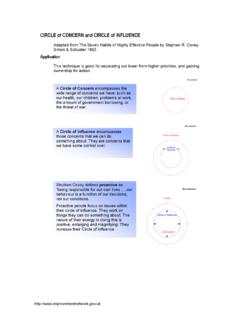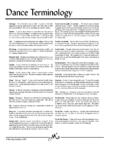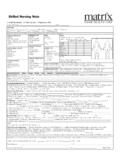Transcription of Developing What is a warm-up? Vocal Technique …
1 !"#"$%&$& Developing Vocal Technique in the Choral Rehearsal Carol J. Krueger, DMA Emporia State University Emporia, KS what is a warm -up? warm -up is an exercise used to stimulate and increase blood flow to the muscles involved, resulting in increased flexibility and less likelihood of injury . A singer s warm -up should also consist of a selection of exercises designed to develop Technique as required. [S. L. Gover, Choral Journal, October 2001] Why warm -up? Prevent Damage/ Vocal abuse; Develop the fundamentals of Vocal Technique (refine and perfect sound); See Vocal Technique Pyramid Maintain the trained voice; Build and/or enhance aural skills; Build and/or enhance listening skills.
2 REMEMBER: Singing is a learned behavior; most people are not natural singers and will require Vocal instruction if they are going to reach their potential. Beginning of rehearsal; Throughout rehearsal; Set the singers up for success; Tailor Vocal exercises to address the needs of the literature. How long? Singers arrive in varying degrees of readiness so length of time varies; A short series of exercises can adjust the mood, order the mind, capture the remaining energies, and relax tense muscles that can alter singing Technique and predispose the singer to Vocal fatigue and injury. (Smith/Sataloff, 111) !
3 "#"$%&%&Who? Responsibility of director; Director doesn t have to be a great singer but must have an ear for excellent Vocal quality and know the process of how to produce that sound. Carefully monitor warm -ups and provide appropriate feedback for the singers. what should be included? Physical and mental warm -up; Articulation exercises that energize the voice; Voiced and unvoiced breathing exercises; Unison melodic exercises for uniformity of vowel and blend; Chordal exercises for intonation and balance; Exercises based on difficult aspects of the repertoire; Exercises to train and develop the ear. How do Vocal solo and choral warm -ups differ?
4 Vocal Solo warm -ups ! Should be extended, detailed, focused on individual needs; ! Focus on alignment, breath motion, flow, and management; ! May cover multiple lifts/breaks and be of considerable length. Choral warm -ups ! Must encourage independence of singing but also focus on ensemble; ! Focus on alignment, breath motion and flow as breath management is best taught in the solo setting; ! Use simple 3-5 note exercises with limited lifts. ! Build esprit de corps so every singer strives to do their best Engage the Mind and Energize the Body Engage the Mind ! Teach singers to think! There is no substitute for intelligence. ! EMPOWER rather than ENABLE.
5 ! The brain is a thinking organ that learns and grows by interacting with the world through perception and action. ! Mental stimulation improves brain function and actually protects against cognitive decline, as does physical exercise. Engage the Mind ! The human brain is able to continually adapt and rewire itself. Even in old age, it can grow new neurons. ! Severe mental decline is usually caused by disease, whereas most age-related losses in memory or motor skills simply result from inactivity and a lack of mental exercise and stimulation. In other words, use it or lose it. ! Try neural building and strengthening exercises with everyday movements. ! Use your opposite hand to brush your teeth, dial the phone, operate the computer mouse, or operate the TV remote.
6 !"#"$%&'&Engage the Mind ! Mirrored Movement ! Touch Canon 4/4, 3/4, 2/4,1/4; ! Use one of three positions: ! together, ! one stationary while one moves; ! two different moves; Engage the Mind ! Metered Movement: ! Raise right arm on 1, 4, 7, 10, while counting: ! Use two opposite motions. 1; 1, 2; 1, 2, 3; 1, 2, 3, 4; 1, 2, 3, 4, 5; 1, 2, 3, 4, 5, 6; 1, 2, 3, 4, 5, 6, 7; 1, 2, 3, 4, 5, 6, 7, 8; 1, 2, 3, 4, 5, 6, 7, 8, 9; 1, 2, 3, 4, 5, 6, 7, 8, 9, 10. 10; 10, 9; 10, 9, 8; 10, 9, 8, 7; 10, 9, 8, 7, 6; 10, 9, 8, 7, 6, 5; 10, 9, 8, 7, 6, 5, 4; 10, 9, 8, 7, 6, 5, 4, 3; 10, 9, 8, 7, 6, 5, 4, 3, 2; 10, 9, 8, 7, 6, 5, 4, 3, 2, 1.
7 Engage the Mind W = WALK W W W W W W W W W W W W W W W C W W W W W W C C W W W W W C C C W W W W C C C C W W W C C C C C W W C C C C C C W C C C C C C C C = CLAP C C C C C C C C C C C C C C C W C C C C C C W W C C C C C W W W C C C C W W W W C C C W W W W W C C W W W W W W C W W W W W W W BEAT AND ANACRUSIS TO THE BEAT !"#"$%&(&Engage the Mind Research indicates that mental exercise can positively affect memory and physical coordination. ! Echo Claps/Chants and ! Canon Claps/Chants Energize the Body ! The whole body is the instrument: singing is an athletic endeavor; ! develop body awareness, ! prepares the singers to sing; ! body must move, can NOT be STATIC or the musical phrase suffers!)
8 Energize the Body ! Rationale ! Learning styles: ! visual [30%], auditory [30%], kinesthetic [15%], multi-modal [30%} ! Involves the singer and on-task behavior (Active vs. Passive) ! Alleviates tension, energizes the body [singer s instrument]; ! To prevent the body from becoming rigid, singers need to be physically involved: take the focus off of the throat and avoid tension. [Choral Journal 38, 1997] ! Creates a physical manifestation of the sound; ! Instruct singers to walk in place (heel march), move hands in circle, snap on off-beat, clap-off, throw a frisbee, throw a dart, hurl the hog , rub pencil between hands, polish piano, place tone in hand; !]
9 "#"$%&#&Energize the Body ! Good for general health; ! Good for the brain; walking increases blood circulation ! As you walk, you effectively oxygenate your brain. Maybe this is why walking can "clear your head" and help you to think better. ! Studies showed that walking improves memory and significantly reduces risk of Alzheimer s and mental decline ! Inactive individuals were twice as likely to develop Alzheimer's, compared to those who exercised vigorously at least three times a week. Exercises that loosen, relax and stretch the muscles ! Entire Body ! Elbow to knees (stand/sit) ! To u c h Yo u r To e s ( s t a n d / s i t ) ! Jumping Jacks ! Krueger Jacks !
10 Shadow Boxing ! Run Through Tires ! Walk in the Park. ! Curtsy squat ! Back Conditioning ! Spinal Stretch, Side Stretch, Rope Climbing ! Shoulder Conditioning ! Shoulder Roll, shrug, swim, shoulder flex ! Back/Shoulder Conditioning ! Massage, light chops, kitty cat scratches; rag doll ! Head Conditioning ! Head roll, The Turtle, Yes/No ! Lower Limbs and Arms ! Heel March, Rub with Towel, Shake It Out, the Lunge ! Facial muscles, tongue and jaw ! Massage temple, cheeks, jaw, neck, tongue base; ! Tighten facial muscles then open the eyes and mouth as wide as possible Beat vs. Rhythm ! Locomotor realization of space Dalcroze; ! Work for continual motion; !


